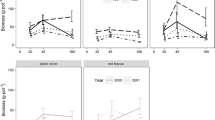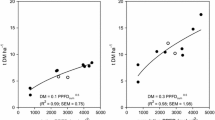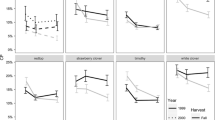Abstract
Thirty forages, including eight introduced cool-season grasses, four native warm-season grasses, one introduced warm-season grass, eight introduced cool-season legumes, five native warm-season legumes, and four introduced warm-season legumes, were grown in 7.6 L (two gallon) pots in full sun, 50%, and 80% shade created by shade cloth over a greenhouse frame. Experiments were conducted during summer--fall 1994, spring--early summer 1995, and summer--fall 1995. A complete randomized experimental design was used and above ground dry weight was measured in each shade environment. Tukey's studentized range test was used to compare mean dry weights (MDW) within a species. Warm-season grasses displayed significant reductions in MDW under shade regardless of growing season. All cool-season forages grown during spring--early summer showed a decrease in MDW under shade; however, the reductions in dry weights of ‘Benchmark’ and ‘Justus’ orchardgrass, ‘KY 31’ tall fescue, Desmodium canescens and D. paniculatum were not significant under 50% shade. Cool-season grasses showed more shade tolerance when grown during the summer--fall than when grown during the spring--early summer. Seven of the selected cool-season grasses grown during the summer--fall did not display significant reductions in MDW under 50% shade as compared to full sun. Smooth bromegrass grown under 50% shade showed a significantly increased MDW production compared to growth in full sun. With the exception of Justus orchardgrass and smooth bromegrass, growth of cool-season grasses was inhibited at 80% shade. Among the legumes harvested during the fall, the dry weights of both Desmodium species tested and hog peanut (Amphicarpaea bracteata L.) increased significantly under 50% and 80% shade. In addition, ‘Cody’ alfalfa, white clover, slender lespedeza and ‘Kobe’ lespedeza showed no significant reductions in MDW under 50% shade.
Similar content being viewed by others
References
Al-khatib K and Paulsen GM (1989) Enhancement of thermal injury to photosynthesis in wheat plants and thylakoids by high light intensity. Plant Physiology 90: 1041–1048
Anderson GW and Batini FE (1979) Clover and crop production under 13 to 15-year-old Pinus radiata, Aust. J. Experimental Agric. Animal Husbandry 19: 362–368
Azcon-Bieto J, Farquhar GD and Caballero A (1981) Effects of temperature, oxygen concentration, leaf age and seasonal variations on CO2 compensation point of Lolium perenneL. Planta 152: 497–504
Baker BS and Jung GA (1968) Effect of environmental conditions on the growth of four perennial grasses. I. Response to controlled temperature. Agronomy Journal 60: 155–158
Björkman O and Holmgren P (1963) Adaptability of the photosynthetic apparatus to light intensity in ecotypes from exposed and shaded habitats. Physiology of Plant 16: 889–914
Blenkinsop PG and Dale JE (1974) The effects of shade treatment and light intensity on ribulose-1,5-diphosphate carboxylase activity and fraction I protein level in the first leaf of barley. J Exp Bot 25: 899–912
Boardman NK (1977) Comparative photosynthesis of sun and shade plants. Annual Review Plant Physiology 28: 355–377
Brown RH and Radcliffe DE (1986) Comparison of apparent photosynthesis in sericea lespedeza and alfalfa. Crop Science 26: 1208–1211
Edwards G and Walker D (1983) C3, C4: Mechanisms, and Cellular and Environmental Regulation, of Photosynthesis. University of California Press. Berkeley, CA
Gist GR and Mott GO (1956) Some effects of light intensity, temperature, and soil moisture on the growth of alfalfa, red clover and birdfoot trefoil seedlings. Agronomy Journal 49: 33–36
Hupe SC (1980) The effects of pole-size black walnut trees on six forage species. Dissertation. University of Missouri at Columbia, 127 pp
Kephart KD, Buxton DR and Taylor SE (1992) Growth of C3 and C4 perennial grasses in reduced irradiance. Crop Science 32: 1033–1038
Kyle DJ (1987) The biochemical basis for photoinhibition of photosystem II. In: Kyle DJ, Osmond CB and Arntzen CJ (eds) Photoinhibition, pp 197–226. Elsevier, Amsterdam
Martsolf JD (1966) Microclimatic modification through shade induced changes in net radiation. Dissertation. University of Missouri-Columbia, 96 pp
McQuigg JD and Decker WL (1958) Solar energy: a summary of records at Columbia, Missouri. University of Missouri College of Agriculture Agricultural Experiment Station. Research Bulletin 671: 4–27
Pearcy W and Franceschi VR (1986) Photosynthetic characteristics and chloroplast ultra-structure of 3-carbon photosynthetic pathway and 4-carbon photosynthetic pathway tree species grown in high and low light environments. Photosynthesis Research 9: 317–332
Pearson HA (1983) Forest grazing in the southern United States. In: Hannaway DB (eds) Foothills for Food and Forests, pp 247–260. Oregon State University, College of Agricultural Sciences symposium Series No.2. Timber Press, Beaverton, Oregon, 383 pp
Powels SB (1984) Photoinhibition of photosynthesis induced by visible light. Annual Review of Plant Physiology 35: 15–44
Smith MA and Whiteman PC (1983) Evaluation of tropical grasses in increasing shade under coconut canopies. Experimental Agriculture 19: 153–161
Watson VH, Hagedorn C, Knight WE and Pearson HA (1984) Shade tolerance of grass and legume germplasm for use in the southern forest range. Journal of Range Management 37: 229–232
Author information
Authors and Affiliations
Rights and permissions
About this article
Cite this article
Lin, C.H., McGraw, R.L., George, M.F. et al. Shade effects on forage crops with potential in temperate agroforestry practices. Agroforestry Systems 44, 109–119 (1998). https://doi.org/10.1023/A:1006205116354
Issue Date:
DOI: https://doi.org/10.1023/A:1006205116354




